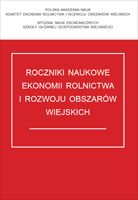Main Article Content
Article Details
Brisson Yan, 2014: The changing face of the Canadian hog industry, Analytical Paper, No 5, Statistics Canada.
Canadian Pork Council, Canadian Hog Farms, http://www.cpc-ccp.com/canadian_hog_farms.php, dostęp: 30.09.2017.
EC (European Commission), 2012: Agriculture in the European Union. Statistical and Economic Information. Report 2012, tab. 3.5.3.10.
Changing structure of pig farms by Member States and Candidate Countries. EC (European Commission), 2016: EU Agricultural Outlook. Prospects for the EU agricultural markets and income 2016-2026.
Eurostat, 2014: Agriculture>Agriculture>Data> Main tables 2014. Agricultural holding with livestock (hold Pigs) and Number of pigs.
Ezekiel Michael, 1938: The Cobweb Theorem, "The Quarterly Journal of Economics", vol. 53, no. 2, 255-280. (Crossref)
Ferris John N., 2005: Agricultural Prices and Commodity Market Analysis, Michigan State University Press, 99-120.
GUS, 2006-2016: Roczniki satystyczne rolnictwa, Warszawa.
GUS, 2009: Zwierzęta gospodarskie w 2008 r., Informacje i opracowania statystyczne, Warszawa.
GUS, 2010: Zwierzęta gospodarskie w 2009 r., Informacje i opracowania statystyczne, Warszawa.
Hamulczuk Mariusz, Stanisław Gędek, Cezary Klimkowski, Stanisław Stańko, 2012: Prognozowanie cen surowców rolnych na podstawie zależności przyczynowych, Program Wieloletni 2011-2014, IERiGŻ-PIB, Warszawa.
"Handel zagraniczny produktami rolno-spożywczymi. Stan i perspektywy. Analizy rynkowe", 2002- 2017: IERiGŻ, ARR, MRiRW, Warszawa, nr 16-45
Jóźwiak Janina, Jarosław Podgórski, 1998: Statystyka od podstaw, PWE, Warszawa.
Kusz Dariusz, 2005: Specjalizacja a efektywność gospodarstw ukierunkowanych na produkcję żywca wieprzowego, "Roczniki Naukowe Stowarzyszenia Ekonomistów Rolnictwa i Agrobiznesu", 7(1), 150-155.
Małkowski Jan, Danuta Zawadzka, 1995: Wahania w produkcji trzody chlewnej w Polsce i innych krajach, Komunikaty, Raporty, Ekspertyzy nr 389, IERiGŻ, Warszawa.
Ritson Christopher, 1977: Agricultural Economics. Principles and Policy, Collins. 8 Grafton Street London W1.
"Rynek Mięsa. Stan i Perspektywy", 2000-2017: IERiGŻ, ARR, MRiRW, nr 19-52.
Stańko Stanisław, 2013: Zmiany i projekcje rozwoju na podstawowych rynkach rolnych w Polsce, Wydawnictwo SGGW, Warszawa.
Stańko Stanisław, Aneta Mikuła, 2016: Tendencje w produkcji, zużyciu krajowym i handlu zagranicznym wieprzowiną, wołowiną i mięsem drobiowym w Polsce w latach 2000-2015. Roczniki Naukowe Ekonomii Rolnictwa i Rozwoju Obszarów Wiejskich, 103(2), 31-40.
Stępień Sebastian, 2015: Cykl świński w świetle zmian na globalnym rynku żywca wieprzowego, Wydawnictwo Naukowe PWN, Warszawa.
Timofiejuk Igor, 1990: Tablice średniego tempa wzrostu według metody R, GUS, Zakład Badań Statystycznych, Warszawa.
Tomek William, G., Kenneth L. Robinson, 2001: Kreowanie cen artykułów rolnych, Wydawnictwo Naukowe PWN, Warszawa
USDA FAS (United States Department of Agriculture Foreign Agricultural Service), 2001-2016: Livestock and Poultry. World Markets and Trade.
Zawadzka Danuta, 2016: Rynek wieprzowiny, [w] Sytuacja na światowych rynkach mięsa i produktów mleczarskich oraz jej wpływ na rynek krajowy i możliwości jego rozwoju, red. Stanisław Stańko, Monografie Programu Wieloletniego nr 31, IERiGŻ-PIB, Warszawa, 58-70.
Downloads
- Agnieszka Kozera, Joanna Stanisławska, Feliks Wysocki, THE FINANCIAL SITUATION OF HOUSEHOLDS IN RURAL AREAS IN POLAND IN THE CONTEXT OF EUROPEAN INTEGRATION , Annals of Agricultural Economics and Rural Development: Vol. 101 No. 2 (2014)
- Agnieszka Sompolska-Rzechuła, Anna Oleńczuk-Paszel, CHANGES IN LIVING CONDITIONS IN RURAL AREAS IN POLAND IN YEARS 2002-2014 , Annals of Agricultural Economics and Rural Development: Vol. 104 No. 2 (2017)
You may also start an advanced similarity search for this article.
- Aneta Mikuła, FOOD SECURITY IN POLAND , Annals of Agricultural Economics and Rural Development: Vol. 99 No. 4 (2012)
- Joanna Kisielińska, Stanisław Stańko, Multidimensional data analysis in agricultural economics , Annals of Agricultural Economics and Rural Development: Vol. 96 No. 2 (2009)
- Stanisław Stańko, Aneta Mikuła, TRENDS IN PRODUCTION, DOMESTIC CONSUMPTION AND FOREIGN TRADE OF PORK, BEEF AND POULTRY MEAT IN POLAND IN THE YEARS 2000-2015 , Annals of Agricultural Economics and Rural Development: Vol. 103 No. 2 (2016)
- Stanisław Stańko, Aneta Mikuła, TRENDS IN POLISH FOREIGN TRADE IN AGRI-FOOD PRODUCTS IN YEARS 1995-2013 , Annals of Agricultural Economics and Rural Development: Vol. 101 No. 1 (2014)
- Bolesław Borkowski, Stanisław Stańko, Remarks concerning the application and applying econometric methods in the economic research , Annals of Agricultural Economics and Rural Development: Vol. 97 No. 2 (2010)
- Stanisław Stańko, Mariusz Hamulczuk, SEASONALITY AND CYCLICAL NATURE OF PRICES AND THEIR RELATIONSHIPS IN PORK MARKETING CHAIN , Annals of Agricultural Economics and Rural Development: Vol. 102 No. 3 (2015)
- Stanisław Stańko, Bogdan Klepacki, Henryk Runowski, 80th Anniversary of prof. dr hab. Zygmunt Wojtaszek , Annals of Agricultural Economics and Rural Development: Vol. 96 No. 4 (2009)
- Stanisław Stańko, Agnieszka Bezat, EFFICIENCY OF POLISH GRAIN TRADE ENTERPRISES AND THEIR LOCALIZATION RELATIVE TO THE SUPPLY MARKETS , Annals of Agricultural Economics and Rural Development: Vol. 98 No. 4 (2011)
- Aneta Mikuła, Stanisław Stańko, LONG-TERM CHANGES IN PRICE RELATIONS IN THE MARKETING CHAIN OF PORK IN POLAND , Annals of Agricultural Economics and Rural Development: Vol. 102 No. 2 (2015)
- Stanisław Stańko, External conditions of development of Polish agriculture , Annals of Agricultural Economics and Rural Development: Vol. 94 No. 2 (2008)




